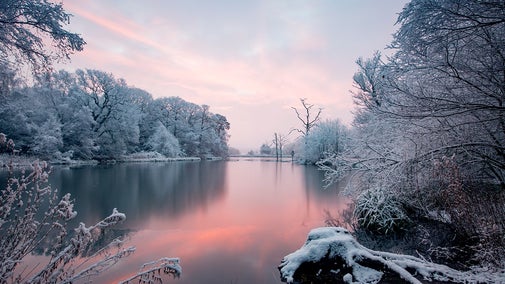
Clumber Park's collections
Explore the objects and works of art we care for at Clumber Park on the National Trust Collections website.

Visitors to Clumber Park may be forgiven for wondering where the house is. Most National Trust country estates have a home at their heart, but of the mansions that previously stood here, little is left. Read on to find out more about the lost mansion, the creation of Hardwick village, the Clumber Spaniel and the parks connections with the Second World War.
Clumber Park was once the country estate of the Dukes of Newcastle. Although Clumber House was taken down in 1938, there are many glimpses of its grand past to explore, including the Duke’s Study (the last remaining room of the house), the Laundry Yard, Turning Yard, the Lincoln Stables, the Chapel of St Mary the Virgin and the walled kitchen garden.
The story of Clumber Park begins in 1709 when John Holles, the 3rd Duke of Newcastle-upon-Tyne, was granted a licence to enclose 3,000 acres of Sherwood Forest and turn it into a deer park for Queen Anne. When he died, his nephew, Thomas Pelham-Holles, the 4th Duke, took on the estate. He died childless but had thankfully made himself the 1st Duke of Newcastle-under-Lyne, a new title which could be handed down to his sister’s son. This meant Henry Fiennes Pelham-Clinton became the 2nd Duke of Newcastle-under-Lyne in 1768, promptly inheriting Clumber Park.
The 2nd Duke was the first to make Clumber Park a home, turning it into an estate dedicated to pleasure on a grand, almost unimaginable scale. He had a mansion built in the early 1760s, designed by Stephen Wright, which was regarded as one of the finest non-Royal houses in the country. A classical building of white freestone (brought from the Duke's own quarry), flanked by a square wing at each corner, with the central portion, which faced the lake, containing a light Ionic colonnade.
The core of the house was the original ducal hunting lodge which had previously existed on the site. This meant that rooms in the centre of the house were not particularly grand, however, those in the new flanking wings more than compensated. The State dining room was 60ft long and 34ft wide and designed to accommodate 150 guests seated at one table. The 4th Duke was a renowned collector and filled Clumber House with many paintings by Gainsborough, Van Dyke, Poussin and Rembrandt to name a few. There were also various treasures, including busts, statues, china and an extensive collection of rare books including a Book of Hours, a first folio Shakespeare, and three Caxtons.

The gardens and parkland of the estate were particularly impressive, both in scale and the care and money that had been lavished upon them. Writing in 1896, Cornelius Brown stated that "The lawns and terraces are laid out with much skill, and tastefully adorned with lofty vases and graceful statuary" and Leonard Jacks, in 1881, described the lawns as "...very fine, smooth, velvety".
The double avenue of lime trees, created for the 5th Duke, was planted with 1,296 trees and stood at three miles long. Today, it still is the longest in Europe.
The lake, added by the 2nd Duke, took 15 years to create by damming the River Poulter and excavating the river bed. It was further enlarged and extended in 1817 and 1885 until it covered 87 acres and was almost two miles long.
The fire on 28 March 1879 was devastating. Not only for the extensive damage to the house, gutting 20 of the 105 rooms, but also the loss of many fine artworks, although many were rescued. The fire destroyed the central core of the house, leaving the wings standing round a hollow shell.
The trustees of the 7th Duke, who was just 15 years old and had inherited Clumber only a few months before, were faced with the quandary as to whether to rebuild. The 6th Duke had been an extravagant spender who had significantly reduced the family fortune. However, as Leonard Jacks stated, the Dukes of Newcastle's rent roll was vast and although they could not replace the artworks, they could rebuild the house.
Charles Barry, whose father was the famous Sir Charles responsible for the Palace of Westminster, was put in charge of the work. He replaced the lost rooms in the centre of the house with an enormous entrance hall, which featured balustraded galleries, tessellated pavements and various niches for the surviving statuary.

Another fire in April 1912 ravaged the upper two floors, and whilst not as serious as the previous fire, added to the burden. When the decision to demolish the house, taken by the 9th Duke who had inherited it, was announced in the local paper, it stated that "the decision to completely demolish the mansion has been taken with great reluctance by the present owner, but it has been necessitated by heavy taxation". Though it played a part, a more significant factor was that Clumber House had been built for a different age; an age of huge, lavish house parties and vast wealth. With the passing of the former and major pressures on the latter, houses on this scale were just no longer sustainable.
The demolition of Clumber House was contracted out to Henry Boot Construction in 1938, with the sale of most of the contents the year before. Thornbridge in Derbyshire, Henry Charles Boot’s home since 1929, was one estate to benefit from much of the statuary and facades from Clumber, along with Newstead Abbey, home to Lord Byron, whose Clumber Lodge is built entirely from materials from Clumber House.
Hardwick village was created in the 1850s, a model village for the 5th Duke’s estate workers. It housed a post office and general store, village hall and two schools; one for village children and the other, for the students of the Clumber Chapel choir, housed in the Choir Hostel also situated in the village. The village school was destroyed by fire in 1932.
Almost everything the dukes needed for their estate could be found within the boundaries of Clumber Park, and the village played no small part in that self-sufficiency. Here, a forestry yard contained a carpentry workshop and a blacksmith’s forge, the latter where much of the Chapel’s decorative ironwork was made.
Today, Hardwick village is under a Covenant of the National Trust, and the village properties under tenancy.
Highlights of Hardwick village

The origins of the Clumber Spaniel breed is uncertain, however, we know the name does derive from Clumber Park. One possibility is that the breed came from France during the French Revolution, when the Duc de Noailles reportedly gave his kennel of prized spaniels to his friend the 2nd Duke of Newcastle.
The earliest known depiction of the breed is in the painting ‘The Return from Shooting’ by Francis Wheatley in 1788. Clumber House can be seen in the distance with the Ornamental Bridge to the left of the painting. Historically, the Clumber Spaniel was bred at the kennels at Clumber Park, and prior to hunts on the estate the dogs were rounded up at either side of the bridge.
Today, the Clumber Spaniels Society work closely with us and regularly meet on the estate.

In 1939, the War Department requisitioned Clumber Park and the 9th Duke handed over the estate. During the Second World War, the park was used by the army for ammunition storage and military training. The Lincoln Stables were used as a decontamination centre, the cricket pavilion as a medical hut and the Duke's garage was used for entertainment and meetings.
Lime Tree Avenue was lined with hundreds of corrugated iron ammunition stores, each containing up to 400 cubic feet of shells including naval shells that stood over 3 feet high. In addition to these stores, there were also Nissen huts built all over the park, including along Lime Tree Avenue. These were used to accommodate army personnel.
After the war, clearing the park of ammunition took many years and it was 1955 before the military eventually left.

NELLIE - trench-digging prototype tank
Winston Churchill was a firm believer in the importance of science and technology in warfare. One of his brainwaves, originally dreamed up during the First World War, was a trench-digging tank, codenamed White Rabbit No. 6 (also known as Naval Land Equipment Tractor, amusingly shortened to ‘Nellie’). Five prototypes were built by Ruston Bucyrus in Lincoln and tested at Clumber Park.
In late 1941, Churchill travelled up to Clumber to see Nellie in action. After a train ride from London, Churchill completed his journey by car and then, for nearly a mile, on foot through the mud to the test site.
The huge machine, measuring 23 metres long (a whopping 75 feet), two metres wide and 2.5 metres high, consisted of two parts. At the rear came the tank, weighing 100 tons, pushing the 30-ton front section which was capable of digging a trench 1.5m deep and two metres wide. While the demonstration was a success, the machines were never used. Overtaken by a very different kind of warfare, Churchill decided to scrap the ill-fated White Rabbit.
The trenches Nellie dug shaped the landscape at Clumber Park, particularly on South Lawns where effects can still be seen today.
In 1946, the National Trust purchased Clumber Park with the aid of donations and opened it to the public in the late 1950s. Conservation work began and continues today.
Find out more thorough our work outdoors.

Explore the objects and works of art we care for at Clumber Park on the National Trust Collections website.
One built a spectacular three storey mansion, another planted 1296 trees to create Lime Tree Avenue. Discover more about the Dukes of Newcastle and how one family changed the landscape of this corner of Sherwood Forest to suit their own private pleasure.

Discover how Clumber Park’s walled kitchen garden is maintained using traditional gardening techniques and is one of only a handful of its kind in existence.

The 19th century Chapel of St Mary is a must-see on a visit to Clumber Park.

From wild adventures in the woods to family bike rides around the estate, there are plenty of ways to make memories at Clumber Park this winter.

Clumber Park is a three pawprint rated place. Exploring the 3,800 acres of beautiful parkland with your dog by your side is one of the best ways to see Clumber Park.

Grade I listed park, Clumber Park is a special and important place. Our conservation work focuses on restoring the park's historic landscapes and protecting rare habitats for the future.

One way to support the National Trust, while also spending time in amazing places and making new friends, is to volunteer. Find out more about joining the dedicated team of volunteers working to make Clumber Park a beautiful place to visit.

Whether you're looking for food, drink or the perfect gift, Clumber Park has something for everyone.
